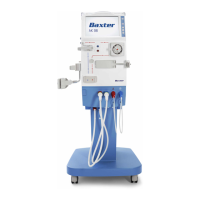A:106 AK 98 Dialysis Machine - Haemodialysis - Single needle treatment
HCEN12745 Revision 10.2016
Program version 2.xx
5.1 Basic functionality
In single needle treatments only one needle is used, but the needle is attached to two
blood lines by a Y connector. The patient’s blood goes in and out of the body in a cycle
with two phases.
1. The Arterial phase. The venous blood line is closed. The patient’s blood enters
the arterial blood line.
2. The Venous phase. The arterial blood line is closed. The cleansed blood is
returned to the patient via the venous blood line.
Parameters in single needle treatment:
● Mean blood flow is the effective mean blood flow rate during the complete arterial
and venous cycle.
● The stroke volume is the blood volume that passes through the dialyzer during a
cycle. A higher stroke volume gives better efficiency.
NOTE!
The volume of the expansion chamber should be as large as possible, and the
volume of the saline/blood in the expansion chamber should be as low as possible
to allow for a maximised stroke volume.
NOTE!
The stroke volume should be maximised to minimise recirculation.
CAUTION!
Use the correct blood pump rotor. Check that it is adjusted correctly for the occlusion
of the blood pump segment being used. This check shall be performed by an
authorised service technician.
5.2 Preparations
WARNING!
Check that there are no kinks in the blood lines before starting the blood pump to
prevent damage to patient blood cells.
When connecting the blood access to the extracorporeal circuit, the operator must
ensure that the air detector is activated and the connections between the blood access
and blood lines are tightly secured. Check that there is no leakage in the blood lines.
Procedure
1) Perform a check before treatment. Follow
the steps in Section 4.2.1 “Check before
2) Start the functional check. Follow the steps
in Section 4.2.2 “Start functional check” on
3) Set up the dialysis machine. Follow the
steps in Section 4.2.3 “Set up the dialysis
4) Attach the arterial blood line. Follow the
steps in Section 4.2.4 “Attach the arterial
blood line” on pageA:79.

